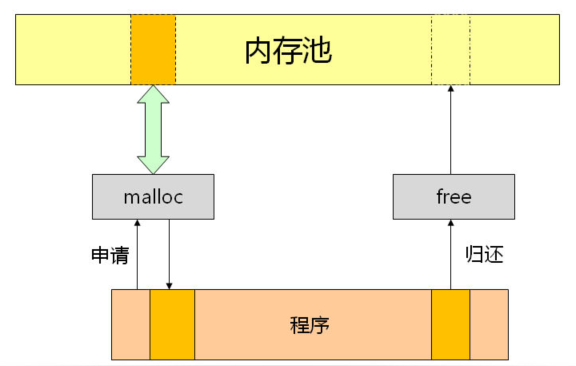1 动态内存分配的意义
-
C语言中的一切操作都是基于内存的
-
变量和数组都是内存的别名
- 内存分配由编译器在编译期间决定
- 定义数组的时候必须指定数组长度
- 数组长度是在编译期就必须确定的
-
需求:程序运行的过程中,可能需要使用一些额外的内存空间
2 malloc 和 free
-
malloc和free用于执行动态分配内存和释放
-
malloc所分配的是一块连续的内存 -
malloc以字节为单位,并且不带任何的类型信息 -
free用于将动态内存归还系统void* malloc(size_t size); void free(void* pointer); -
注意
malloc和free是库函数,而不是系统调用malloc实际分配的内存可能会比请求的多- 不能依赖于不同平台下的
malloc行为——为了移植性 - 当请求的动态内存无法满足时,
malloc返回NULL - 当
free的参数为NULL时,函数直接返回
-
问题1:
malloc(0);将会返回什么?-
Demo
#include <stdio.h> #include <malloc.h> int main() { int* p = (int*)malloc(0); printf("p = %p ",p); free(p); return 0; } -
运行结果 => malloc(0)是合法的,但申请的内存长度为0
p = 0x895a008
-
-
问题2:如果不断地执行
malloc(0);但是不进行内存释放,会产生内存泄漏么?- 会:
malloc实际分配的内存可能会比请求的多,malloc(0);可能得到的内存是 4 个字节大小
- 会:
-
实例:内存泄漏检测模块
-
Demo
#include <stdio.h> #include "mleak.h" void f() { MALLOC(100); //自定义的malloc函数,这里没有进行内存释放 } int main() { int* p = (int*)MALLOC(3 * sizeof(int)); f(); p[0] = 1; p[1] = 2; p[2] = 3; FREE(p); //自定义的free函数 PRINT_LEAK_INFO(); //打印当前内存泄漏的信息 return 0; } //mleak.h #ifndef _MLEAK_H_ #define _MLEAK_H_ #include <malloc.h> #define MALLOC(n) mallocEx(n, __FILE__, __LINE__) #define FREE(p) freeEx(p) void* mallocEx(size_t n, const char* file, const line); void freeEx(void* p); void PRINT_LEAK_INFO(); #endif //mleak.c #include "mleak.h" #define SIZE 256 /* 动态内存申请参数结构体 */ typedef struct { void* pointer; int size; const char* file; int line; } MItem; static MItem g_record[SIZE]; /* 记录动态内存申请的操作 */ void* mallocEx(size_t n, const char* file, const line) { void* ret = malloc(n); /* 动态内存申请 */ if( ret != NULL ) { int i = 0; /* 遍历全局数组,记录此次操作 */ for(i=0; i<SIZE; i++) { /* 查找位置 */ if( g_record[i].pointer == NULL ) { g_record[i].pointer = ret; g_record[i].size = n; g_record[i].file = file; g_record[i].line = line; break; } } } return ret; } void freeEx(void* p) { if( p != NULL ) { int i = 0; /* 遍历全局数组,释放内存空间,并清除操作记录 */ for(i=0; i<SIZE; i++) { if( g_record[i].pointer == p ) { g_record[i].pointer = NULL; g_record[i].size = 0; g_record[i].file = NULL; g_record[i].line = 0; free(p); break; } } } } void PRINT_LEAK_INFO() { int i = 0; printf("Potential Memory Leak Info: "); /* 遍历全局数组,打印未释放的空间记录 */ for(i=0; i<SIZE; i++) { if( g_record[i].pointer != NULL ) { printf("Address: %p, size:%d, Location: %s:%d ", g_record[i].pointer, g_record[i].size, g_record[i].file, g_record[i].line); } } } -
运行
-
3 calloc 和 realloc
-
malloc的同胞兄弟void* calloc(size_t num,size_t size); void* realloc(void* pointer,size_t new_size); -
calloc的参数代表所返回内存的类型信息 -
calloc会将返回的内存初始化为0 -
realloc用于修改一个原先已经分配的内存块大小- 在使用
realloc之后应该使用其返回值 - 当
pointer的**第一个参数为NULL时,等价于malloc**
- 在使用
-
对比
malloc单纯地从系统中申请固定字节大小的内存calloc能以类型大小为单位申请内存并初始化为0realloc用于重置内存大小,如果内存重置为一个更大的内存空间,扩充的部分为随机值
-
示例:
calloc和realloc的使用-
Demo
#include <stdio.h> #include <malloc.h> #define SIZE 5 int main() { int i = 0; int* pI = (int*)malloc(SIZE * sizeof(int)); short* pS = (short*)calloc(SIZE, sizeof(short)); for(i=0; i<SIZE; i++) { printf("pI[%d] = %d, pS[%d] = %d ", i, pI[i], i, pS[i]); } printf("Before: pI = %p ", pI); pI = (int*)realloc(pI, 2 * SIZE * sizeof(int)); printf("After: pI = %p ", pI); for(i=0; i<10; i++) { printf("pI[%d] = %d ", i, pI[i]); } free(pI); free(pS); return 0; } -
GCC 编译运行
pI[0] = 0,pS[0] = 0 pI[1] = 0,pS[1] = 0 pI[2] = 0,pS[2] = 0 pI[3] = 0,pS[3] = 0 pI[4] = 0,pS[4] = 0 Before : pI = 0x9241008 After : pI = 0x9241438 pI[0] = 0 pI[1] = 0 pI[2] = 0 pI[3] = 0 pI[4] = 0 pI[5] = 0 pI[6] = 0 pI[7] = 0 pI[8] = 0 pI[9] = 0 -
VS 编译运行
pI[0] = -842150451, pS[0] = 0 pI[1] = -842150451, pS[1] = 0 pI[2] = -842150451, pS[2] = 0 pI[3] = -842150451, pS[3] = 0 pI[4] = -842150451, pS[4] = 0 Before: pI = 014B5650 After: pI = 014B5650 pI[0] = -842150451 pI[1] = -842150451 pI[2] = -842150451 pI[3] = -842150451 pI[4] = -842150451 pI[5] = -842150451 pI[6] = -842150451 pI[7] = -842150451 pI[8] = -842150451 pI[9] = -842150451
-